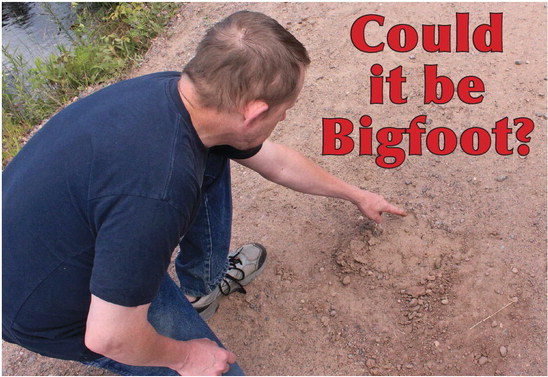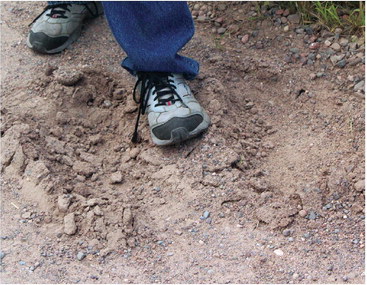Area man questions origin of mysterious prints


Could it be Bigfoot?
Whatever caused the impressions on Wood Creek Avenue at its crossing of the Wood Creek had to be both big and heavy.
Jeffery Wiitala was out fishing with his son Arick when they stopped at the river crossing. “I was checking to see if there was some trout in the stream,” he explained. When he looked at the marks near the edge of the north side of the road he did a double take, wondering what kind of animal was able to make a track like that.
Wiitala, who works in logging, said he has spent most of his life in the woods in northcentral Wisconsin and had never seen anything like these tracks. “Whatever made them had to have weighed at least 1,000 pounds,” Wiitala said, guessing that from the distance between the prints whatever made them was over seven feet tall.
“I knew it wasn’t a bear,” he said, noting he is familiar with those and other wildlife tracks. He stomped down on the hard pan gravel surface of the road noting its rock-hard compaction in the late summer afternoon and saying anything that caused a mark in the road needed to be pretty big.
Wiitala points out that wildlife of all types use river and streams corridors as highways. He points out the telltale signs of displaced undergrowth and tree branches that lead into the surrounding woods from the bank of the stream. He theorized that whatever caused the marks in the road had jumped up from the stream bank and landed hard on the roadway on two feet leaving imprints at least an inch deep and about 16 inches long. Wiitala theorizes the animal then jumped forward to another set of prints about eight feet away. He points out the outline of what looks like rounded toes in the edge of the second set of prints. In addition to the first two pairs of impressions, there were two more sets of prints that were shallower than the first two continuing to where an animal trail leads down the bank and into the surrounding woods.
“We don’t know everything that might live in the woods,” Wiitala said. He took pictures of the prints with his cellphone and contacted the Taylor County Sheriff’s Department who relayed it to Wisconsin Department of Natural Resources conservation warden Kurt Haas.
Haas said that in his 13 years of law enforcement and as a warden this was his first call of a suspected Bigfoot sighting. Haas compared it to the calls that would come in over the years claiming a cougar was sighted in the area and that it was only just a few years ago one was actually confirmed here. He said that when these sorts of cases are called in, they are treated with the same level of professionalism as any other calls, and they make a point of going out and gathering information and trying to make sense of what it was.
While this was the first reported evidence of possible Big Foot activity in Taylor County, Wisconsin has had numerous sightings over the years. According to Big Foot Field Researchers Organization (BFRO), there have been 102 sightings in Wisconsin, with nearby Price County recording eight separate sightings of the elusive cryptid. Marinette County is the state’s hotspot for sightings with nine reported sightings. Wittala’s son, Justin, said he saw a glimpse of one there while visiting his mother’s family.
BFRO was founded in 1995 and describes itself as a “virtual community of scientists, journalists, and specialists from diverse backgrounds.” According to the organization’s website, “the BFRO organizes and reports observations and directs expeditions to places where the observations have occurred. Through this process, the BFRO steadily improves the size and scope of its collective expertise about these animals.”
BFRO theorizes that the animal called alternatively Big Foot or sasquatch is a type of large ape spotted mostly in forested regions with abundant protein sources. Deer in particular. They theorize that the low population number is what keeps them from becoming a nuisance for humans and their livestock.
According to the BFRO, the term “sasquatch” is an anglicized derivative of the word “Sésquac”, meaning “wild man.” The original word, in the Stó:lõ dialect of the Halkomelem language, is used by the Coast Salish Indians of the Fraser Valley and parts of Vancouver Island, British Columbia. They explain that native tribes across North America have a total of more than 60 different terms for the sasquatch. Many different terms have been used by pioneers and later nonnative inhabitants of North America, including “skookums” and “mountain devils.”
Despite years of searching by BFRO and other groups, the existence of Big Foot and other cryptids around the globe remains unproven. For his part, Haas can neither confirm nor deny the existence of a Big Foot in Taylor County, but he said there could also be less mysterious reason for the markings in the road suggesting they could be the marks of the stabilizer feet of a end loader that was using a claw to remove debris from the culvert opening.
Wiitala remains convinced that whatever made the marks he saw on the road is still out there in the woods somewhere. He explained that while he used to feel safe being alone in the woods or fishing with his sons along the many isolated creeks and streams, he is thinking that in the future he might be bringing his sidearm along with him, just in case.

Jeff Wittala compares the size of the parallel tracks with his own foot. His theory is that a massive humanoid animal jumped up onto the roadway causing the deep prints before jumping ahead and leaving another set. DNR conservation warden Kurt Haas suggests the prints had a more mundane source such as from a piece of road equipment.BRIAN WILSON/THE STAR NEWS






